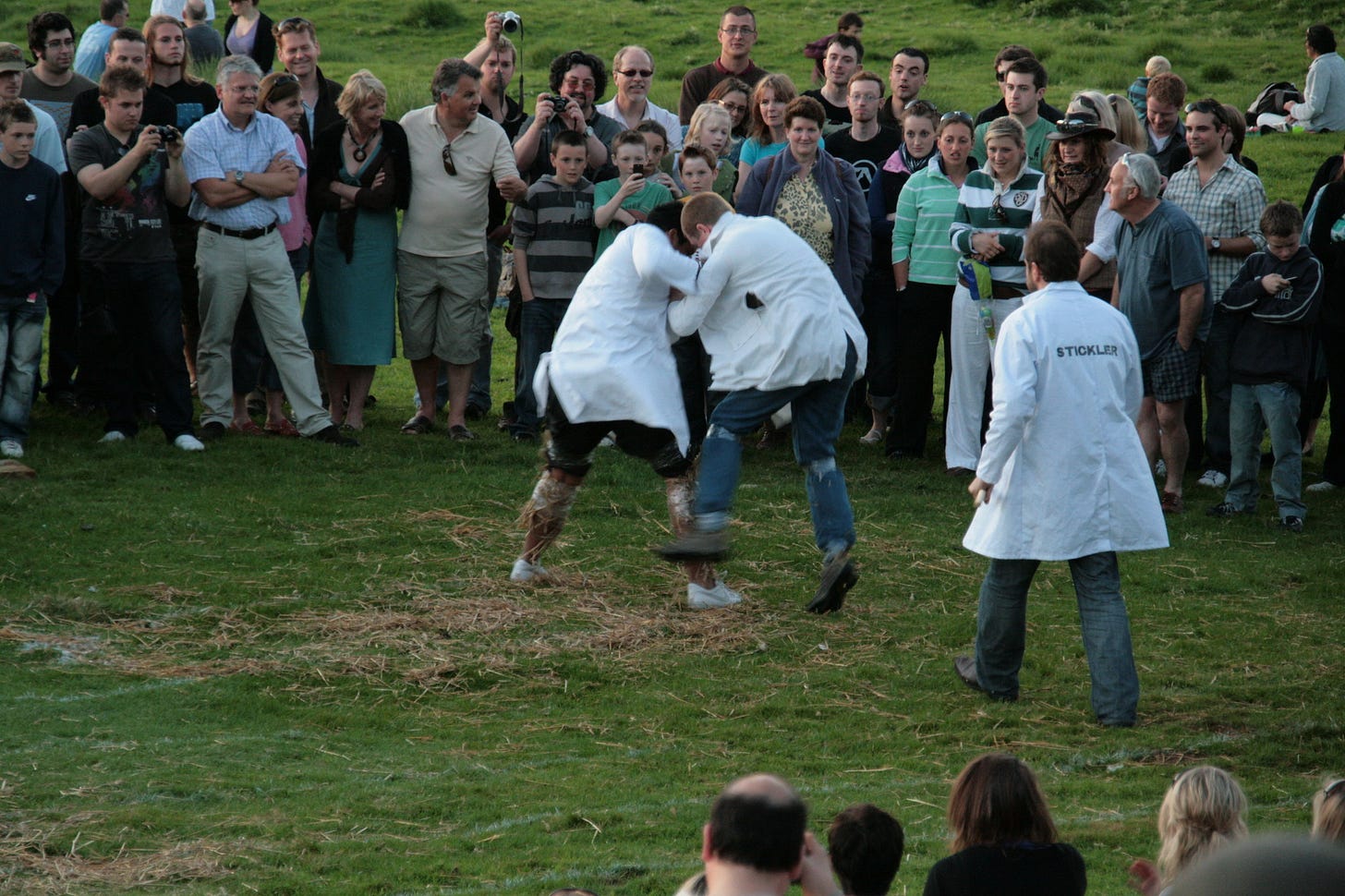Small sports, small mercies
#24: Lacrosse and the Haudenosaunee Nationals, flag football lifers, amphibians of the archipelago, and the strongest shins in England...

Tales from the fringes of sport and society…
There's something to be said about the quirkier the birth, the quirkier the sport. Take ultimate frisbee. Not only did the object in question begin life as a pie tin in the early 20th century, but its rules and structures were formalised in the 1960s by a bunch of students that included the future producer of The Matrix, Joel Silver.
Then there’s padel, which emerged in 1969 when wealthy Mexican Enrique Corcuera didn't have enough room in his home to build a full-size tennis court. The modern form of parkour was moulded by the French son of a firefighter who was inspired by his father's military feats in Vietnam.
Curling began 400 years ago when bored Scottish people began sliding stones on frozen lochs using wooden brooms. Even further back, lacrosse is deeply-rooted in the culture of the Indigenous peoples of North America, particularly the Haudenosaunee (Iroquois). More recently in Sweden, Otillo's island-to-island swimrunning owes its creation to a drunken wager.
You’re unlikely to have played any of the above sports. You might not even have heard of some of them. But while they may be niche pursuits, there's nothing quirky or kooky to its elite participants who - despite a lack of popular acclaim - partake with full throttle dedication and passion.
Many of those dream of a day when the spotlight may cast a little more of its rays their way. When they can hand in their notice at work and tell their boss their part-time passion is now a full-time career. Breaking into the mainstream brings money, eyeballs, and long overdue recognition. But it also brings scrutiny, criticism, and competition.
Emerging sports that make it to the Olympics don't always encounter the utopia they dreamed of. Sport climbing made the grade at Tokyo and enjoyed a return in Paris, but the non-traditional format demanded by the IOC resulted in a bitter fracture within the climbing community.
The breakdancing scene also experienced the crueller side of the mainstream glare, with a widely-mocked Olympic debut. Sullen B-boys and B-girls around the world learned very quickly that the phrase “all press is good press” is absolute hokum.
The roads look fraught for the next cabs off the rank too. Padel's phenomenal growth has found resistance from local and national tennis federations, who aren't sure whether to see the upstart as a little sister to nurture or a rival to fear. Bitter disputes will surely stunt the newcomer’s growth.
Meanwhile, lacrosse will be in LA but its brilliant indigenous team, the Haudenosaunee Nationals, will not be allowed to compete by the IOC. Flag football, the non-contact version of American football devised by US soldiers during the Second World War, will also make its Olympic debut in LA in 2028. But the players who've helped to grow the sport may find themselves shoulder-barged out of the team by the big names of the NFL, who’ve admitted to a Gollum-esque infatuation with Olympic treasure.
It's a fiendish dilemma that athletes of other fringe sports are acutely aware. When I was working on this piece for the BBC last year, I spoke to a couple of Britain's top ultimate frisbee players. The sport now has over 100 national federations and is a strong contender to feature at the Brisbane Olympics in 2032. While you might expect that representing their country at the highest level would be the default dream of any sportsperson, both Leila Denniston and Tom Abrahams explained how it's not as simple as that when it comes to lesser-loved sports.
"The fact that the sport is amateur allows me to have balance in my life, have a job, I can think about having a family, I can maintain relationships and friendships," admitted Denniston.
"I have loads of things I want to contribute outside of sport and I want to wed sport with my wider life in a way that being a professional athlete probably wouldn't offer me. I really hope that what's special about frisbee doesn't get lost in this push for international representation."
Abrahams, meanwhile, took a self-deprecating tone, "You can play the most niche sport in the UK, but if it's in the Olympics and you've got a chance of winning a medal, you can probably be a professional at it. Which is an awesome opportunity. But from a personal level, if frisbee was a sport played by two million people in the UK, I probably wouldn't be at the top of the sport. It wouldn't be all of us who are here now. You'd have loads of other people who would be competitors."
It’s a scenario that the world's top flag footballers may well encounter in LA in three years time. For small sports yearning for the big time, it’s a case of be careful what you wish for.
In this edition of Off-Field, we bring you a selection of tales from ambitious fringe sports you’re unlikely to have watched, played, or even knew existed. All of them boast a thriving sub-culture and unique history that is well worth your attention.
Enjoy the read.
Amphibians of the Archipelago
The Stockholm Archipelago is the home of Ötillö, a swimrun challenge considered one of the world’s toughest endurance events. Beginning at dawn, pairs must traverse the route’s 24 islands before dusk. To do so, they must negotiate 46 transitions involving 6 miles of open-water swimming and 38 miles of trail running. What's more, they do so while tied together by rope.
In Off-Field Volume 1, our debut print anthology featuring 250 pages of original longform stories the likes of which we recommend every month in this newsletter, we document the travails of physio Amanda Nilsson and firefighter Adriel Young as they sought to become Ötillö’s first mixed-gender team to make the overall podium.
As you can see from the photos below, we’re excited to report that Off-Field is one step closer to fruition and will soon be in our hands. Many thanks to those who’ve pre-ordered, we expect to have delivery dates for you very soon. For anyone yet to order, hit the button below!



They invented the game. Will they be allowed to play it in the Olympics?
New York Times
“At the time, LA28, the organizing committee of the 2028 Olympic and Paralympic Games in Los Angeles, was on the cusp of adding lacrosse. But though the lacrosse World Championships have included the Haudenosaunee Nationals since 1990, making them the only Indigenous national team accepted by a major international sports federation, the International Olympic Committee does not consider the Haudenosaunee eligible as a national team, and thus is not allowing them to participate in the Games.”

NFL stars or flag football lifers: who deserves Olympic gold in 2028?
Culture of Sport
“For years, flag football lived in the shadows of its full-contact cousin, embraced in parks, schools, and rec leagues but often overlooked at the elite level. That changed in 2023 when the International Olympic Committee approved the sport’s inclusion in the 2028 Los Angeles Games. For players who’ve spent decades growing the sport, it was a moment of validation. For the NFL’s biggest stars, it was an intriguing new opportunity. But now that those two worlds are colliding, a philosophical question has emerged: who should get the Olympic nod, those who built the game of flag football or the powerhouses of the NFL?”

The strongest shins in England
Dispatch
“Anthropologically speaking, shin-kicking is more significant than people realise,” he says. “Every culture on Earth has developed some form of wrestling - it’s one of the few universal expressions of humanity, like singing, dancing, cooking, storytelling. In that context, shin-kicking is England’s wrestling. And the Cotswold Olimpicks are the only place in the world where it still happens.”

The tangled past and unsettled future of greyhound racing in West Virginia
Oxford American
“The semblance of wildness - of pure, beastly instinct - crossed with a semblance of order, and control. As with horseracing, the risk of catastrophe is part of the rush. Much of the arguing about greyhound racing is bound by this cognitive gap, with one side describing a win-win in which dogs - clearly and specifically built to haul ass - do so for our enjoyment and economic gain, and the other citing the many problems, perversions, and cruelties involved in forcing one variety of a favored species to do our esoteric bidding - under the banner, no less, of honoring their natural instincts.”

How dozens of Brazilians made Decatur the capital of American bull riding
D Magazine
“The next face of bull riding will come from Decatur, not to it. With his smooth cheeks and excitable drawl, John Crimber looks 19 going on 14: central casting to play a teenage Woody in a live-action prequel to Toy Story. Nothing about him is intimidating - until he hops on a bull.”
That near death thing: inside the most dangerous race in the world
Rick Broadbent
“The TT is a twisted mongrel of an event and is loved and reviled in equal measure. It splits opinion, divides families and wrecks lives. Hundreds have been lost since that first race in 1907, when the riders got acid burns due to chemicals sprayed on the road to combat the dust. Most of the casualties have been riders, but some were marshals and others spectators. For years the fatal attraction has been a difficult subject, hushed away by the organisers as the anti-TT brigade grew more militant in its banning calls. I wanted to know what drove these people to ride the TT.”
When it comes to sporting events that have a niche but fervent following, few can rival the Isle of Man TT. Widely regarded as the most dangerous race in motorsport, over 250 riders have died since its first iteration in 1907. Despite its inherent risks, thousands flock to the island every year to participate as a rider, official, or spectator.
It’s a thrilling and hair-raising event, but it only seems to pique the interest of a wider - often critical - public in the aftermath of a tragedy. And so, its passionate followers are quite content to continue unloved and unjudged on a noisy island in the Irish Sea.
Broadbent's book takes us to the heart of the race as seen through the eyes of four of its most charismatic racers as they endure the razor-edge tension between life, death, and glory on the Isle of Man.
Thanks for reading June’s edition of Off-Field. If you enjoyed it, use the buttons below to like the newsletter, post a comment, or share it with others.
You can get in touch at hello@off-field.net
Read previous editions of Off-Field at offfield.substack.com/archive
Subscribe free for future editions of Off-Field, or share it with a friend:
“Even if you don't have all the things you want, be grateful for the things you don't have that you don't want” - Bob Dylan










